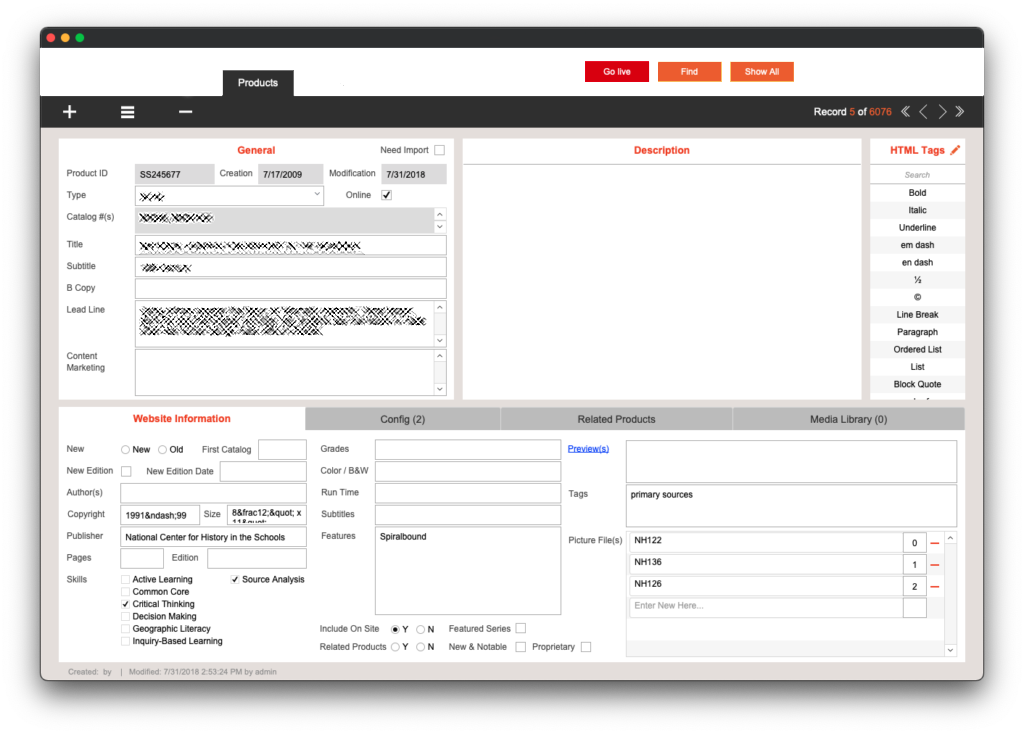Linking FileMaker, WordPress & WooCommerce to manage product listings
The Power of Three – Linking FileMaker, WordPress & WooCommerce to Manage Product Listings for Print Catalog & Webstore Sales
How eXcelisys is helping a large-scale K-12 curriculum distributor close the book on its content management misery

The Client: A leading developer, publisher and distributor of K-12 learning materials with annual revenue exceeding $27+ million (according to Dun & Bradstreet). The client distributes 15,000+ titles from 1,000+ publishers and produces its own materials through imprints.
The Task: Upgrade client’s FileMaker databases (v. 6 & 12). The company used two databases – one by the editorial/art department to manage product descriptions and layout information for a physical catalog, the other to populate the website. The goal: streamline to eliminate task redundancy (i.e., copying, pasting & re-typing information). Earlier, the client had hired a separate web developer to re-do its website and needed the new FileMaker database ASAP to allow time for the web developer to integrate the systems.
The Hiccup: Several months and development dollars later, the other web developer tanked the project. The client hired eXcelisys to fix the flawed website, integrate the new Claris FileMaker database, and sync the FileMaker and WooCommerce data fields.
“We became their go-to development team. We didn’t just build a solution. We built a whole ecosystem of solutions.”
~ eXcelisys Project Manager Kurt Knippel
Task 1: Build a FileMaker Database to Populate the Website Catalog
The old system. To make a long, labyrinthine story short, let’s just say the process involved running Word-created product descriptions through a macro for conversion to a .TXT file that could be copy/pasted into FileMaker. After a little dance with the ERP to grab pricing information, the resulting file was eXported to FileZilla, then pushed to website folders before making a grand entrance onto the website catalog.
Drawbacks to the old system:
- Multi-step
- Time-consuming
- All-or-nothing: There was no way to simply update 1 product; everything in the FileMaker database was pushed to the website and updated each time the update process was launched
The new system. Product description and related details are keyed in FileMaker (v. 17). When complete, the user hits a “Go live” button to update the product on the website. As before, the system is connected to the client’s ERP to grab inventory information like pricing, ISBN, etc. Web catalog details are coded directly in FileMaker, eliminating the need for macro conversions. “Now, they have a whole pallet of HTML format options available right in FileMaker,” said eXcelisys developer Joe Cellino, the mastermind behind the new database. “They can insert HTML code to make it bold, change the text color, and so forth. When it exports to the website, it’s all set.”

Benefits of new system:
- No more macro conversions.
- Control over website updates. Updates are no longer an automatic, all-or-nothing proposition. “They wanted to push updates at their own will,” said Cellino, who devised a workflow that allows the client to conduct a search to find everything that’s been updated, then test it, and go live. This gives the client the ability to update an entire product line without worrying that half-completed updates will be pushed to the website before they are ready.
- Easy product linking. With a complex product structure (many products have supplemental texts, workbooks, maps, DVDs, etc.) the client needed the ability to connect products for web searches. The new FileMaker database allows the client to set workflows to link products as needed.
- Super responsive. Keeping the product updates in FileMaker instead of making them directly in WooCommerce eliminates latency issues with loading web pages. “They can zip through products, updating data quickly in FileMaker,” said Cellino.
Task 2: Rescue Website / Sync FileMaker & WooCommerce Data Fields
eXcelisys delivered the FileMaker web catalog system (described above) in ample time to allow the other developer to integrate the solution with the new website before the scheduled launch. However, six months after eXcelisys completed its portion of the project, the website remained unfinished and the frustrated client asked eXcelisys to take over. eXcelisys web app developer Michael Suhrbier dove in, tidying up the dysfunctional build to get the new site launched. One of the main issues involved syncing the FileMaker and WooCommerce data fields — a task the other developer struggled to complete.
Website Issues that Needed Fixing
- Data syncing. Suhrbier tinkered with the API to create flawless linking between FileMaker and WooCommerce. As he explained it, there are many custom/specialty fields available only in FileMaker and the same for WooCommerce. The trick to FileMaker/WooCommerce integration is getting those specialty FileMaker fields to show up in the WooCommerce shopping experience in a usable fashion. “We use Advanced Custom Fields to fill in the blanks – the missing holes – for fields that exist in FileMaker but not WooCommerce. This is the missing link for a lot of people when they decide they want to get their FileMaker to WooCommerce. Sure, there’s an API that will do it, but only stuff that matches — like the title and quantity — will work. Lots of data gets dropped off. That’s where developers get stuck and give up.” By using WordPress’ Advanced Custom Fields function to load and display the custom field values, Suhrbier did not have to write any .php code to configure the data fields for the client’s eCommerce site, thus saving development time.
- A plethora of messy plugins & customizations. Suhrbier found that the previous web developer had used some 50 plugins and heavily modified the WordPress parent theme to get the site to look right on the front end. Suhrbier said the developer should have created a child theme to make the customizations instead of editing the actual theme. This setup meant that the client would never be able to update the WordPress theme to the latest version (as needed for security) because it would overwrite all customizations and wreck the site. Suhrbier fixed this issue, parsed unneeded plugins, and devised a system to make plugin updates quickly to reduce downtime in maintenance mode and keep the staging and production sites synced to ensure web orders are not missed.
“We got it across the line to where it could launch.”
~ eXcelisys web app developer Michael Suhrbier
Task 3: Rework FileMaker Database that Populates Print Catalog
Along with the eCommerce web catalog, the client offers its products through print catalogs distributed to school districts. To facilitate the catalog-production process, eXcelisys took the client’s eXisting FileMaker solution (v. 6) and added the features necessary for print catalog production. This involved removing unneeded fields and ensuring the data would eXport into InDesign to speed print production. The physical catalog shares much of the same core information as the web catalog, so the systems were linked to share data. The team that deals with the web catalog listings is separate from the editorial/art team that produces the physical catalog so having separate customized FileMaker modules allows each team to see the data logged in the way that fits their specific workflow.
Task 4: Streamline Auxiliary eCommerce Sites

Aside from its flagship eCommerce website, the client operates a half-dozen other websites that offer the same products broken down into narrower curriculum categories. Each has its own domain, its own look, and its own shopping cart. Currently, eXcelisys is working to bring those auxiliary sites under the umbrella of the main site’s WordPress platform to allow the sites to share underlying functionality.
The current setup is a nightmare for the client’s IT team, which has to oversee maintenance on each site, including seven shopping carts. In addition, every product update must be made separately on each site. eXcelisys is working to fix this.
Who is the super-satisfied client?
The client prefers to fly under the radar and did not want to get involved with our case study, but we can tell you this – the client gave us a 5-star review and called us eXcellent and accommodating in meeting their needs.
If you need a little help syncing those tricky FileMaker/WooCommerce data fields, or care to discuss some other type of customization to automate workflows, contact us today. Our solution consultants will be happy to discuss the possibilities.
To read more web tips and tricks from our web app developers, check out eX-Cetera, our blog where we offer WordPress Tips and Tricks and Web Tips and Tricks.
The post Linking FileMaker, WordPress & WooCommerce to manage product listings appeared first on eXcelisys.





Recommended Comments